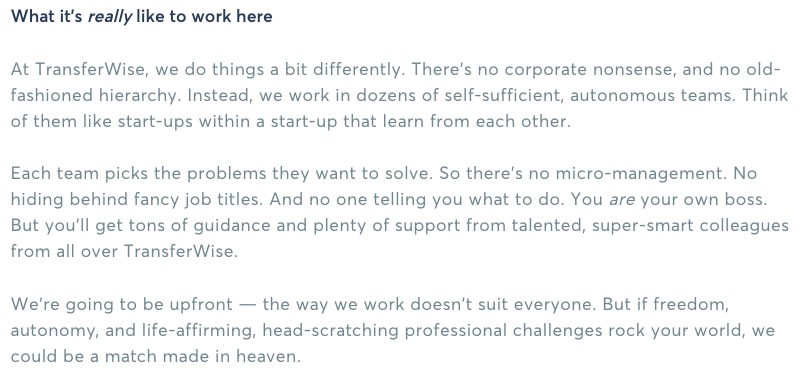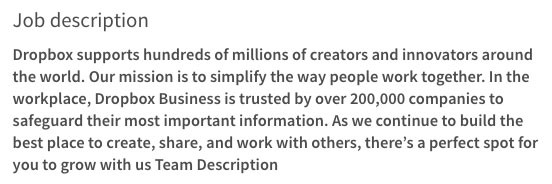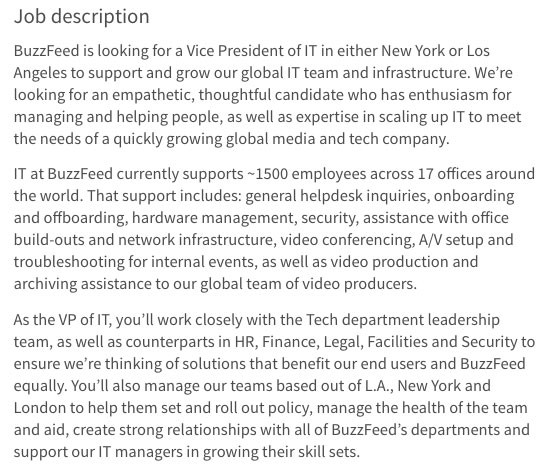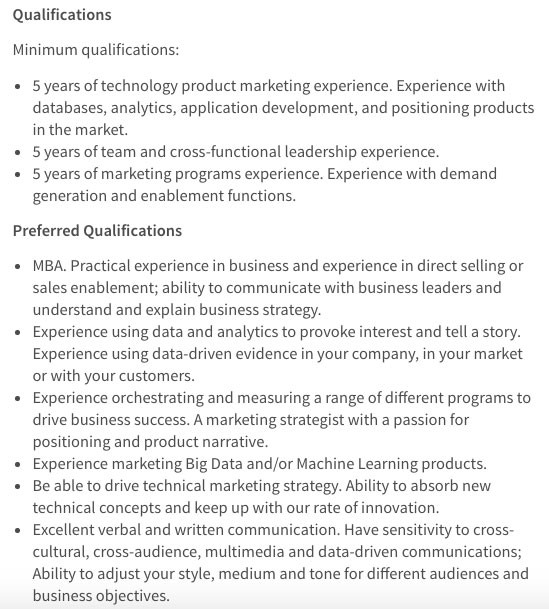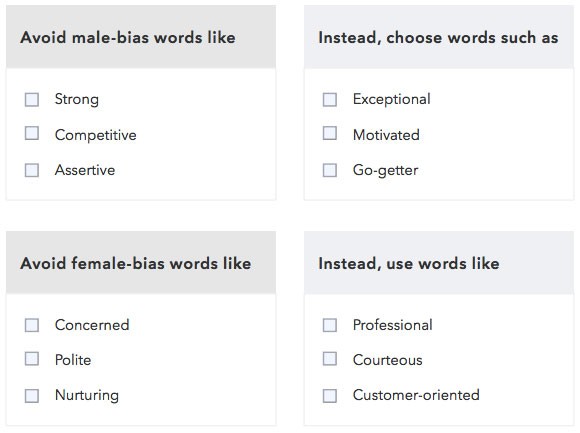How to Nail the 6 Key Parts of a Job Description
If you don’t spend hours crafting the perfect job description, it’s understandable. After all, according to LinkedIn's Global Recruiting Trends 2017 report, 56% of recruiting leaders say that their hiring volume will increase in 2017. It’s not like you're swimming in free time.
But the thing is, spending a little bit longer thinking through that job post can make a big difference in the candidates you attract. Not only is this your chance to stand out and share why working for you is so great, it’s also your chance to get real and help candidates who wouldn’t be a good fit self-select out.
To help you make sure you're covering all your bases, we put together a Killer Job Description Checklist as well as some examples of how other companies are getting it right. Here are the six steps you should follow:
1. Job title: Keep it honest, simple, and keyword-driven
This isn’t the part of the description where you need to get overly creative. The key here is to accurately describe the position and make sure job-seekers searching for a job like this can find it.
Look at this posting by the website-building company Weebly, asking for a “Senior Android Engineer.” Just three words tell us a lot. The posting could have been less precise by asking for a Senior Software Engineer, but instead Weebly’s making the specific ask for an Android developer, eliminating a lot of candidates who don’t want to work on Android software.
And by making it clear this is a senior position, the post also describes where the job fits on the company’s totem pole, something that should be included whenever possible—so candidates can self-select and immediately know if they’re likely to qualify for the position.
One more tip: Keep the position title straightforward rather than exaggerated. If you’re looking for a new Senior Customer Service Rep, go with that, rather than a Customer Support Guru, which could entail a variety of tasks. This also helps make your job post is search engine optimized, meaning that people looking for that type of role will be more likely to find it while searching on Google.
2. Why join us? Connect with candidates on an emotional level
In this section, you’ll make your best sell for why the candidate should join your company. You’ll want to keep it concise and describe the job in a way that showcases its benefits and opportunities (e.g., for growth, collaboration, leadership) before you describe the nuts-and-bolts requirements of the position later in the post.
Describing your culture is essential, as 66% of candidates say the thing they want to know most about your company is your culture and values, according to the 2016 Talent Trends survey. And, not knowing what it’s like to work for you is the #1 roadblock they face when changing jobs.
That said, here are two key components to include in your job description:
First, your company’s unique culture and team dynamics. Look at how payment facilitator TransferWise does this, in its search for a Lead Designer:
Don’t you get a great idea of what it’s like to work there? It’s a small team, you work independently, you get the chance to problem-solve with your autonomous team. You have a vivid picture of what it’s like to work there—something candidates really value—and you also have a real sense of the company’s culture.
Second, your mission, vision, and values.
The first paragraph of this Dropbox job description makes the company’s mission and vision very clear.
It also does something else: describes the company’s industry impact, another great thing to include in a job description.
3. What we’re looking for: Grab the attention of prospects
This is your chance to describe your ideal candidate. First off, what traits would this person possess? What are their capabilities? By giving them a clear picture of what the job entails, they’ll be able to figure out if it’s a good fit. Note that according to recruiting pro Lou Adler, it’s best to describe the job as a series of critical performance objectives, not a laundry list of skills.
In BuzzFeed’s search for a VP of IT, the company makes it clear from the start what kind of soft and hard skills you should possess. The media company is searching for a “thoughtful” person who has “enthusiasm for managing and helping people.”
Secondly, you’ll need to describe the skills and experience needed. Look at what Google does here in searching for a Product Marketing Leader. They want a multidisciplinary leader who combines “the skills of entrepreneur, strategist, marketing visionary and cross-functional team leader.”
The post continues to be very specific about the responsibilities needed, written in a clear tone without using jargon.
4. Describe the impact: the job’s influence, day-to-day experience, and opportunities
Express the position’s value within the company. You want to describe the role—where do they fit in the company and what the daily responsibilities are like. This is where it’s important to work closely with the hiring manager to develop an employee value proposition (EVP) on why the spot is a better job for someone who already has a good job doing similar work.
Also, make the impact of each task clear with an action verb in the present tense. Back to Dropbox–in this case, they’re looking for a Software Engineer. Dropbox’s recruiters chose to frame the position’s impact like this:
“The New York City office has a small, talented team that works on impactful projects that are essential to Dropbox’s success. As an early member of Dropbox NYC Engineering, you’ll have the unique opportunity to build critical product features and infrastructure while shaping the direction of the team and the office.”
Nailed it. You know how big your team is, that your input will be valued because it’s a team that’s recently gotten started, and the impact (written with active verbs) your work will have: the opportunity to build critical product features and shape the direction of your team.
Another tip, in this section, is to fully disclose any potential drawbacks of the job instead of hiding them with clever language. This will weed out any candidates who dislike traveling, or say, having to work independently for long periods of time.
5. Be strategic in the way you phrase things and your word choice
A study published in the Journal of Business and Psychology found that adding “needs-supplies” statements that focus on what candidates want attracts almost 3x as many highly rated applicants than those that only use “demands-abilities” descriptions that focus on what the employer wants.
For example, the sentences below replace generic terms, like “the successful applicant” with a more direct word: “you”!
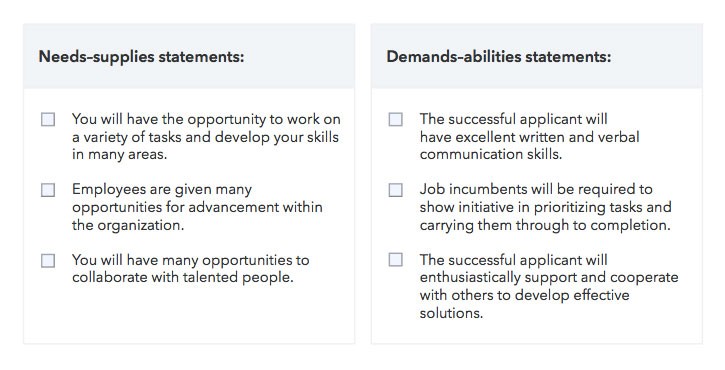
While these changes are small, they can make a big difference in whether or not a candidate is attracted to the role.
6. Make it easy for candidates to apply
Finally, though it sounds obvious, you’ll want to include an easy way for candidates to start their application—such as a clear “Apply Now” button at the end of the listing on your website. If it works for your team, you could even include the application fields right on the posting page, as Weebly does. Bonus here (since it will save them time) if you let them apply with their LinkedIn profile.
This was a brief list of essential components of any job description, along with standout examples to inspire your writing. For the complete Job Description Checklist and more, check out Chapter 2 of our 2017 Ultimate Hiring Toolbox. In all, the free interactive toolbox, full of checklists and templates, has 10 chapters covering every recruiting process, from sourcing to onboarding.
*Image by Alex Scott
To receive blog posts like this one straight in your inbox, subscribe to the blog newsletter.
Topics: Job descriptions
Related articles




